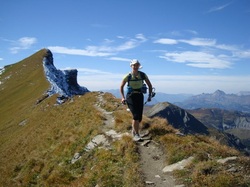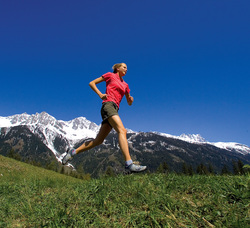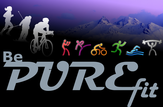
1. Relax and Enjoy!
The essence of trail running is about fun and freedom, running in spectacular scenery, and exploring new ground. No two runs are ever the same – even on the same route - so forget speeds, heart rate zones, and 10km times for a bit - and just concentrate on running freely and fluidly.
2. Walk before you Can Run.
Unless you are uber fit, the rule of thumb for running in the mountains is: walk the ups, run the flats and jog the downs. It’s often just as quick to power walk up and save a bit of energy, rather than arrive at the top of a hill too wasted and wobbly to enjoy the descent.
3. Cross Train.
Trail Running is much kinder to your body than pounding pavements, but running generally is pretty brutal on your joints and muscles. Mix in biking, swimming, core strength, surfing, paragliding, dancing – whatever floats your boat. Balance your body, challenge your muscles with different activities, and be a better runner for it.
4. Safety First!
Running in the mountains is amazing, but never forget there are very real dangers out there. Rock fall, weather, slippery paths, steep descents, tree roots to trip on … sunburn! You're running in remote areas, potentially a long way from help. So, plan your route, tell someone where you’re going, carry a phone, fluids, food, basic first aid kit, and a map. Ideally run with at least 1 other person.
5. Learn to Pole Dance.
As you build up to longer distances, running / nordic walking poles become invaluable. They bring your upper body into the mix, making you more efficient, giving you extra balance, support, and control. Most people can power uphill significantly faster with poles, and descend more safely with them when it’s technical.

Learn to eat and drink on the go. If you’re going out for longer than an hour hike/run then make sure you carry food and fluids. You’ll need to start replenishing lost sugars, salts and fluid from as early as 30 minutes in – and keep topping up at least every 30 minutes throughout your run. If you’re training for an event use the foods and drinks you’ll carry on the day. If you’re not sure, experiment with different sports nutrition and real food.
7. Core Strength.
Trail running requires much more agility, control, proprioception and core strength than road running. No two steps you take are ever the same and the control you need to keep your balance and drive you forward comes from your core. Add a core class, pilates or yoga to your weekly plan.
8. Don’t over do it!
Build up your distance/time slowly. Your cardio vascular fitness increases quickly but your muscles and joints don't always adapt as fast – so you may feel fitter, but your body can be vulnerable to injury. The rule of thumb is increase training by 10% per week. If you’re training for an event, work backwards from the event to create a training plan that will help you avoid injuries.
9. Pace Yourself.
Slow it down, and learn to find a pace you can sustain. Of course, sometimes it’s good to do a short sharp hill session and get your heart pumping, but long distance running is about finding a pace you can keep going at. If you can exchange a bit of banter, then you’re probably about right. If you can’t talk, SLOW DOWN. You’ll enjoy it more, and you’ll surprise yourself how much further/longer you can go.
10. Ask for Help!
Mountain running is a lot more technical than most people give it credit for. Chamonix is full of personal trainers, International Mountain Leaders, Physios, Sports Massage Therapists, Pilates / Yoga teachers, and sports shop assistants – who are all passionate runners. You don’t necessarily need to pay for advice – it's a sociable, friendly sport, and most trail runners are more than happy to give you a few tips and help spread the lycra love!
HAVE FUN and HAPPY RUNNING.
Steph x
ps. If you'd like to learn more about Trail Running, we have 3 trail running holidays in Chamonix this summer, run in partnership with Tracks and Trails. Click here for more info.

 RSS Feed
RSS Feed
